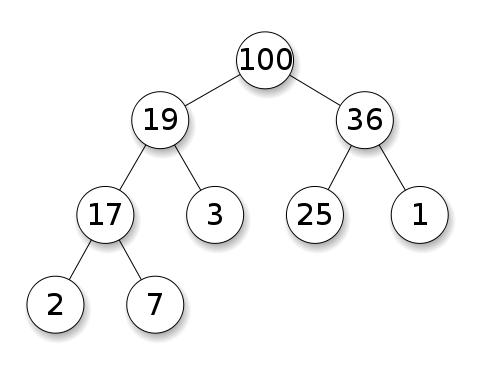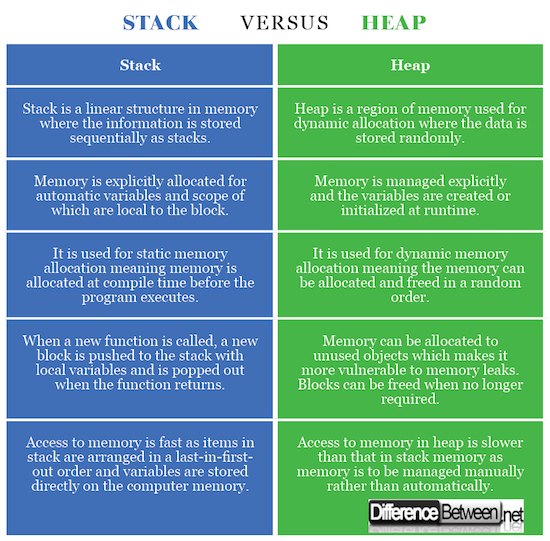Difference Between Stack and Heap
Memory management is a fundamental phenomenon of the operating system used to handle or manage primary memory in order to control the memory access rights on the computer. The goal is to prevent any process from accessing the memory that has not been allocated to it yet.
The operating system allocates memory for each process which is divided into segments. Stack and Heap are the two ways memory is allocated in the operating system.
Stack segment is used to store local function variables that are created automatically, whereas heap segment is used for dynamically allocated memory.
Both are stored in computer RAM and they can grow and shrink during the execution of a program. Let’s discuss the two in detail and compare them to understand which one is better.
What is Stack?
Stack segment is a memory management technique used for static memory allocation. It is a special area in computer’s memory which is used to store local function variables. When a function is called, memory is allocated to all local variables somewhere and you can access those variables as you know their locations. The memory blocks are freed when the function terminates. Stack is one of the ways to implement this process efficiently. Think of it as a basic data structure where items are arranged on top of each other like a stack. Similarly, local variables can be accessed with pushing and popping. Pushing refers to adding items into the stack and popping means retrieving items from the stack. Items can be accessed from the stack in the last-in-first-out (LIFO) order.
What is Heap?
Heap refers to a large pool of memory used for dynamic memory allocation which means memory remains allocated until the program is terminated or the memory is freed. Memory is allocated randomly so there is no easy way to access the memory. Unlike stack segment, elements are being freed in the reverse order as they were originally allocated. In simple terms, memory is allocated to the programs upon request and freed when no longer required. Elements of the heap are independent of each other meaning they can be accessed as the program runs and freed when the program terminates. It’s like a global memory pool used to store global variables and many variables referencing it.
Difference between Stack and Heap
Meaning of Stack and Heap
In computer architecture, a stack is a special region of the computer’s memory explicitly allotted for automatic variables. In programming, automatic variable is a local variable meaning the scope of the variable is local to the block in which it is declared. Memory is allocated automatically to these variables upon entry to the block and memory is freed upon exit. Heap, on the other hand, is the portion of computer’s memory used for dynamic memory allocations meaning blocks of memory are allocated and de-allocated in a random fashion.
Memory Allocation for Stack and Heap
Stack is used to store local variables and the scope of which are defined within the function. In technical terms, stack supports static memory allocation which corresponds to local static variables and scope variables. Memory is allocated before the program is executed, generally at the compile time and the data structure used is called stack. Heap, on the other hand, is used for dynamic memory allocation meaning memory is allocated manually at the runtime during the execution of a program. Programs request memory, usually for adding a node to the data structure and returns if not needed.
Access to Stack and Heap
A stack is managed and optimized by the CPU and the data is accessed in a last-in-first-out (LIFO) order. LIFO refers to the method of data storage in memory stacks in which the most recent block of memory is the first to be freed and vice-versa. This makes for efficient memory management. Elements of the heap, on the contrary, are independent of each other and data can be accessed arbitrarily meaning a memory block can be allocated and freed at any time irrespective of their order. Unlike stacks, heaps have no definite pattern for allocation and deallocation of memory blocks.
Variables in Stack and Heap
Memory is managed automatically in stack and the variables are allocated and deallocated automatically meaning the stack is reserved only for temporary variables. The local variables become active when a function is executed and when it terminates, the variables go out of scope meaning the scope of the variable is local to a function and exists as long as that function executes. Unlike in stack, memory is allocated as the program runs in heap which makes it a little slower to access the variables stored here. As there is no specific order in reserving blocks, memory blocks can be allocated and free at any time.
Stack vs. Heap: Comparison Chart
Summary of Stack vs Heap
Both are the most common ways of memory allocation and are stored in computer’s RAM for efficient memory management. However, access to memory in a stack is fast because memory is managed automatically whereas in heap, memory is to be managed manually meaning you need to allocate the free memory yourself when the blocks are no longer required. Stack is obviously faster and easier to use thanks to its flexibility, but it has its fair share of pros and cons. Though stack has no limit on memory size, it’s a little hard to implement. Heap is slower than a stack, but its implementation is simpler.
- Difference Between Caucus and Primary - June 18, 2024
- Difference Between PPO and POS - May 30, 2024
- Difference Between RFID and NFC - May 28, 2024
Search DifferenceBetween.net :
Leave a Response
References :
[0]Langsam. Data Structures Using Java. New Delhi: Pearson Education India, 2003. Print
[1]Sierra, Kathy and Bert Bates. Head First Java: A Brain-Friendly Guide. Sebastopol: O’Reilly Media, 2005. Print
[2]Dingle, Adair. Software Essentials: Design and Construction. Boca Raton, Florida: CRC Press, 2014. Print
[3]Image credit: https://upload.wikimedia.org/wikipedia/commons/thumb/e/e1/Stack_%28data_structure%29_LIFO.svg/640px-Stack_%28data_structure%29_LIFO.svg.png
[4]Image credit: https://upload.wikimedia.org/wikipedia/commons/thumb/3/38/Max-Heap.svg/500px-Max-Heap.svg.png



